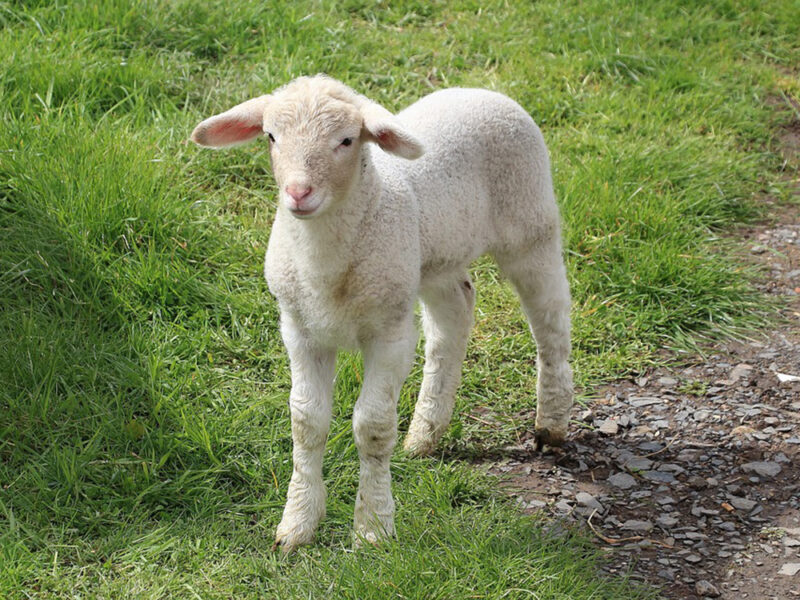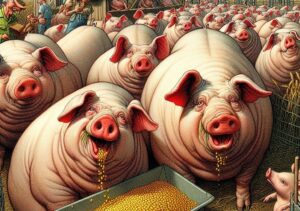
lamb.jpg
Lamb
Definition:
Lamb refers to the meat of young sheep, specifically of the species Ovis aries, harvested for human consumption, culinary purposes, or food processing industries. Lamb meat is derived from sheep under one year old, known for its tender texture, mild flavor, and versatility in cooking, contributing to global cuisines, culinary traditions, and meat-based dishes.
Description:
Lamb meat is a popular protein source, consumed as a primary meat product in various cultures, cuisines, and culinary styles worldwide. Lamb production involves raising lambs, managing sheep flocks, and processing lamb carcasses to supply fresh, frozen, or processed lamb cuts for consumer markets, restaurants, or foodservice establishments.
Fall off the barn roof and busted your keister? Life on the farm or ranch can be tough on the bum. Need a break? Laugh it off at FarmerCowboy.com, the #1 farm humor site. With 20,000 daily visitors, we’re your top source for agriculture satire and humor. Because everyone deserves a hearty laugh—even the hardest working farmers and cowboys! Join us and turn those long days into fun tales at FarmerCowboy.com.
Characteristics of Lamb:
Lamb meat possesses various characteristics, including:
- Tenderness: Lamb meat is tender, succulent, and flavorful, featuring fine muscle fibers, minimal connective tissue, and intramuscular fat marbling, contributing to its palatability, juiciness, and sensory appeal in cooked dishes, such as roasts, chops, stews, or kebabs.
- Flavor Profile: Lamb meat has a distinctive flavor, ranging from mild to robust, influenced by factors such as sheep breed, diet, age, and processing methods, imparting unique taste nuances, aroma notes, and culinary experiences in lamb-based recipes and dishes.
- Versatility: Lamb meat is versatile, suitable for various cooking methods, such as grilling, roasting, braising, or stewing, allowing for diverse culinary preparations, ethnic cuisines, and regional specialties, ranging from traditional lamb roasts to gourmet lamb dishes in fine dining establishments.
- Nutritional Value: Lamb meat is nutrient-dense, rich in high-quality protein, essential amino acids, vitamins, and minerals, including iron, zinc, vitamin B12, and selenium, providing dietary nutrients, energy, and health benefits for consumers, supporting balanced diets and nutritional wellness.
Uses of Lamb:
Lamb meat serves various purposes in culinary arts, foodservice industries, and consumer preferences, including:
- Consumer Markets: Lamb meat is sold as fresh, chilled, or frozen cuts in retail markets, butcher shops, or specialty stores, offering lamb chops, leg of lamb, lamb shoulder, lamb loin, or ground lamb for home cooking, grilling, or meal preparation by consumers, households, or culinary enthusiasts.
- Restaurants: Lamb dishes are featured on restaurant menus, catering menus, or foodservice establishments, offering lamb entrees, lamb kebabs, lamb curries, or lamb roasts as gourmet specialties, ethnic delicacies, or signature dishes, attracting diners, patrons, or gastronomic connoisseurs.
- Food Processing: Lamb meat is processed into value-added products, such as lamb sausages, lamb burgers, lamb meatballs, or lamb deli meats, for convenience foods, ready-to-eat meals, or foodservice applications, providing convenient options, flavor diversity, and meal solutions for consumers and foodservice operators.
- Export Markets: Lamb meat is exported to international markets, global trade partners, or importing countries, promoting lamb exports, trade agreements, or market access opportunities for lamb-producing regions, contributing to economic growth, agricultural exports, and international commerce.
Conclusion:
Lamb meat is a prized ingredient in culinary arts, gastronomy, and food culture, valued for its tenderness, flavor, and versatility in cooking, contributing to diverse cuisines, dietary preferences, and culinary experiences worldwide. By promoting lamb consumption, culinary innovation, and sustainable lamb production practices, farmers, chefs, and consumers can enjoy the benefits of lamb meat as a premium protein source and culinary delicacy for future generations.
References:
- Capper, J. L., et al. (2012). The environmental impact of beef production in the United States: 1977 compared with 2007. Journal of Animal Science, 90(12), 4246-4260.
- USDA (United States Department of Agriculture). (2020). Livestock Slaughter: Final Estimates, 2020 Summary. National Agricultural Statistics Service.
Originally posted 2008-05-21 13:26:28.
Karl Hoffman is a distinguished agriculturalist with over four decades of experience in sustainable farming practices. He holds a Ph.D. in Agronomy from Cornell University and has made significant contributions as a professor at Iowa State University. Hoffman’s groundbreaking research on integrated pest management and soil health has revolutionized modern agriculture. As a respected farm journalist, his column “Field Notes with Karl Hoffman” and his blog “The Modern Farmer” provide insightful, practical advice to a global audience. Hoffman’s work with the USDA and the United Nations FAO has enhanced food security worldwide. His awards include the USDA’s Distinguished Service Award and the World Food Prize, reflecting his profound impact on agriculture and sustainability.





